Deployment Options
Thirdlane Multi Tenant and Thirdlane Business Phone System products enable telephony, messaging, audio and video conferencing, screen and file sharing, CRM and other business applications integrations.
The products are packaged as CentOS based Linux distributions or as images for public cloud deployment. Thirdlane products are easy to install, configure and manage. Updating is simple, fast and safe.
Customers install and run Thirdlane the way that works best for them - in AWS, Google Cloud, Azure, in private data centers, on bare metal servers or virtual machines.
Thirdlane Deployment Options
Thirdlane can be installed anywhere - on bare metal servers, in VMs, and in private or public cloud such as AWS or Google. You can install it yourself, or get help from Thirdlane team which has extensive experience in different types of installations.
Thirdlane Configurations
Thirdlane has thousands of installations ranging from small companies with a handful of users, to MSPs and UCaaS providers or large organizations with thousands of users.
The requirements for system capacity and reliability vary. Some companies may tolerate minimal downtime, while others choose to do everything possible to increase system availability and avoid downtime at all cost.
To satisfy all these requirements, Thirdlane can be deployed in a number of different configurations.
Here are some diagrams on how Thirdlane can be deployed on a single or multiple servers. For simplicity, we are omitting the applications and services that run on the servers.
Thirdlane on a single server
Single server configuration is common for smaller installations of Thirdlane.

Advantages:
- Easy to set up and maintain
- Can be on bare metal or virtualized
- Can be updated to 2 node HA Cluster if needed
Disadvantages:
- No instantaneous failover
When to use:
Your installation is small, automatic failover is not absolutely required, and you don’t want to immediately invest in redundancy and high availability as you have your own backup and recovery strategy.
Thirdlane redundant HA cluster
Thirdlane HA Cluster consists of 2 nodes in redundant active / passive configuration with data replication and automatic failover. This is a very common option for the Thirdlane Multi Tenant option..

Advantages:
- Easy to set up and maintain
- Easy to update with no down time during update
- Can be on bare metal or virtualized
- Near instantaneous failover in case of server failure
- Can be updated to multi node cluster if needed
Disadvantages:
- Limited by the call processing capacity of one server
- No automatic failover in case of data center failure
When to use:
Your installation is not very large but downtime is unacceptable so you choose redundancy and high availability
Thirdlane high capacity cluster
Thirdlane high capacity cluster brings your Thirdlane installation to the next level of capacity and scalability - you are no longer limited by a single server. It typically deployed for installations exceeding a few thousands users and by service providers planning for growth.

With Thirdlane cluster deployment all system management and some communication components run on redundant Manager nodes. These include Configuration Manager web GUI, database server, Kamailio SIP server and optional Asterisk. The Manager nodes work in active/passive mode and thus provide automatic failover in case of the Primary node failure.
Worker nodes run Asterisk servers and do not require redundancy as high capacity SIP servers, running on Manager nodes, routes calls to multiple Worker nodes based on a selected routing strategy. Cluster capacity can be easily increased by adding Worker nodes when needed.
Advantages:
- High capacity with near unlimited growth
- Easy to update with no down time during update
- Easy to add servers for increased capacity
- Near instantaneous failover in case of server failure
- Can be updated to geo-redundant multi node UC Cluster if needed
Disadvantages:
- More complex to set up and maintain
- Higher infrastructure cost
- No automatic failover in case of data center failure
When to use:
Your installation is growing fast and you need redundancy and high availability.
Thirdlane high capacity cluster with geo-redundancy

This is a preferred design for service providers seeking maximum system availability, especially those with customers in multiple geographic locations.
This design adds one or more locations with same or similar size cluster, connected via high speed network.
Advantages:
- Automatic failover in case of data center failure
- High capacity with near unlimited growth
- Easy to update with no down time during update
- Easy to add servers for increased capacity
- Near instantaneous failover in case of server failure
Disadvantages:
- More complex to set up and maintain
- Higher infrastructure cost
- May require manual recovery procedures
When to use:
Your installation is growing fast, you have geographically distributed customers and you want protection against data center failure.